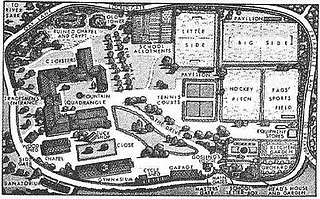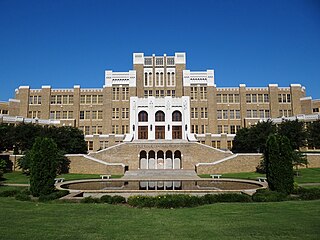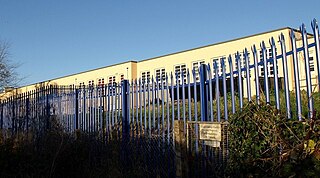
Roman numerals are a numeral system that originated in ancient Rome and remained the usual way of writing numbers throughout Europe well into the Late Middle Ages. Numbers are written with combinations of letters from the Latin alphabet, each letter with a fixed integer value. Modern style uses only these seven:

A student is a person enrolled in a school or other educational institution.
In the education systems of England, Northern Ireland, Wales, Jamaica, Trinidad and Tobago and some other Commonwealth countries, sixth form represents the final two years of secondary education, ages 16 to 18. Pupils typically prepare for A-level or equivalent examinations like the International Baccalaureate or Cambridge Pre-U. In England, Wales, and Northern Ireland, the term Key Stage 5 has the same meaning. It only refers to academic education and not to vocational education.

A chord, in music, is any harmonic set of pitches consisting of multiple notes that are sounded simultaneously, or nearly so. For many practical and theoretical purposes, arpeggios and other types of broken chords may also be considered as chords in the right musical context.

Education in Germany is primarily the responsibility of individual German states, with the federal government only playing a minor role.

Greyfriars School is a fictional English public school used as a setting in the long-running series of stories by the writer Charles Hamilton, who wrote under the pen-name of Frank Richards. Although the stories are focused on the Remove, whose most famous pupil was Billy Bunter, other characters also featured on a regular basis.

A secondary school or high school is an institution that provides secondary education and also usually includes the building where this takes place. Some secondary schools provide both lower secondary education and upper secondary education, i.e., both levels 2 and 3 of the ISCED scale, but these can also be provided in separate schools.

The Blue Coat School is a co education Church of England academy for 11- to 18-year-olds, located in the town of Oldham, Greater Manchester, England.

University College School, also known as UCS, is an independent day school in Frognal, Hampstead, London, England. The school was founded in 1830 by University College London and inherited many of that institution's progressive and secular views.
The folkeskole is a type of school in Denmark covering the entire period of compulsory education, from the age of 6 to 16, encompassing pre-school, primary and lower secondary education.
Eleventh grade is the eleventh year of formal or compulsory education. It is typically the third year of high school. Students in eleventh grade are usually 16–17 years of age.
Year 12 is an educational year group in schools in many countries including England, Wales, Northern Ireland, Australia and New Zealand. It is sometimes the twelfth year of compulsory education, or alternatively a year of post-compulsory education. It usually incorporates students aged between 16 and 18, depending on the locality. It is also known as "senior year" in parts of Australia, where it is the final year of compulsory education. Year Twelve in England and Wales, and in New Zealand, is the equivalent of Eleventh grade, junior year, or grade 11 in the US and parts of Canada.

Torquay Girls' Grammar School is a selective grammar school for girls aged 11–18, in Torquay, Devon, UK. It is situated directly beside Torquay Boys' Grammar School, and became one of the first schools to achieve Humanities Specialist School status in September 2004, as well as one of the first to offer the AQA Baccalaureate. On 1 February 2011, the school officially gained academy status. It is a member of the South West Academic Trust – a collaboration of seven high-performing grammar schools and Exeter University. The examination results regularly place the school in the top twenty state girls' schools nationally.

Gymnasium, in the German education system, is the most advanced and highest of the three types of German secondary schools, the others being Hauptschule (lowest) and Realschule (middle). Gymnasium strongly emphasizes academic learning, comparable to the British sixth form system or with prep schools in the United States. A student attending Gymnasium is called a Gymnasiast. In 2009/10 there were 3,094 gymnasia in Germany, with c. 2,475,000 students, resulting in an average student number of 800 students per school.
Educational stages are subdivisions of formal learning, typically covering early childhood education, primary education, secondary education and tertiary education. The United Nations Educational, Scientific and Cultural Organization (UNESCO) recognizes nine levels of education in its International Standard Classification of Education (ISCED) system. UNESCO's International Bureau of Education maintains a database of country-specific education systems and their stages. Some countries divide levels of study into grades or forms for school children in the same year.
Therfield School is a coeducational secondary school and sixth form located in Leatherhead, Surrey, England. Therfield School sixth form teaches courses of further education for students between the ages of 16 and 18 and has an arrangement of reciprocated entry criteria with three others in the county: The Ashcombe School, Warlingham School and Oxted School.
A Remove class in education is or was a group of students at an English public school, typically a year group: for example the year group between the fourth form and the fifth form. In the state maintained secondary schools the Remove class was a class for pupils who had already moved through Fifth Form but needed to resit the Ordinary Level ('O'level) GCE examination.
Wednesfield Grammar School was a grammar school in Wednesfield in the West Midlands of England. It opened on the Wednesfield site in 1960; and merged with March End Secondary Modern in 1969 to form Wednesfield High School.
Education in Brunei is provided or regulated by the Government of Brunei through the Ministry of Education and the Ministry of Religious Affairs. The former manages most of the government and private schools in the country where as the latter specifically administers government schools which provide the ugama or Islamic religious education.









